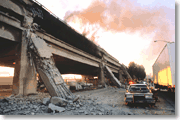 |
 Reassessing Disasters Reassessing Disasters
|
 |

Natural
Hazards Response Requires New Approach, Study Says
The cost of
natural hazards in the United States has averaged
as much as $1 billion per week since 1989 and is expected
to keep rising, according to a new study released
on May 19 at the National Press Club in Washington,
D.C. In some cases, steps taken to reduce the impact
of natural hazards may actually make the situation
worse when more extreme disasters occur, said Dennis
Mileti, who led the study team of 132 experts. The
five-year, $750,000 study -- titled Disasters
by Design: A Reassessment of Natural Hazards in the
United States -- was funded primarily by the
National Science Foundation's [NSF] Engineering Directorate.
The Federal Emergency Management Agency [FEMA], the
U.S. Geological Survey [USGS], the U.S. Forest Service
and the Environmental Protection Agency [EPA] also
contributed funding. The study team was asked to evaluate
what is known about natural hazards and come up with
ways to reduce their social and economic costs. "The
really big catastrophes are getting larger and will
continue to get larger, partly because of things we've
done in the past to reduce risk," Mileti said.
More...
|
 |

More...
|
 |

NSF
Grant Brings "Virtual Worlds" to Life
Supported
by the National Science Foundation (NSF), researchers
at the University of California, Los Angeles (UCLA)
are developing "virtual worlds" that one day could
allow planners nationwide to design better cities
by "visiting" a computer-generated metropolis or where
firefighters could consult "digital buildings" to
decide how to battle a blaze. Using a $1.3-million
NSF grant, an interdisciplinary team of researchers
led by Richard R. Muntz, the chairman of UCLA's computer
science department, have drawn from research in field
as diverse as architecture, computer science and psychology
to develop three-dimensional computer models for the
"Virtual World Data Server." The team has created
complex simulations that may eventually lead to new
ways to study problems in fields from urban planning
to physics and surgery.
More...
|
 |

S&E;
Degrees to Women, Minorities on the Rise, Math Achievement
"Gender Gap" Is Gone
The number
and proportion of women and minorities enrolled and
earning undergraduate and graduate science and engineering
[S&E;] degrees continues to increase, while the number
of white men doing so is decreasing, according to
a National Science Foundation [NSF] report recently
released to Congress. Between 1982 and 1994, the percentages
of black, Hispanic and American Indian students taking
many basic and advanced mathematics courses doubled.
And the 1996 National Assessment of Educational Progress
[NAEP] mathematics assessment results showed that
the "gender gap" in mathematics achievement has, for
the most part, disappeared, says Women, Minorities,
and Persons with Disabilities in Science and Engineering:
1998, a report by NSF's Division of Science Resources
Studies [SRS]. Despite these gains, women, minorities,
and persons with disabilities remain underrepresented
in science and engineering fields, said the ninth
in a series of Congressionally mandated reports on
the status of women and minorities in science and
engineering.
More...
|
 |
 
|

